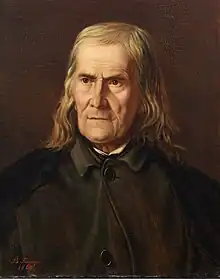Tirukkural translations into German
Among the European languages, German has the third highest number of translations of the Tirukkural, after English and French. As of 2015, there were at least eight translations of the Kural text available in German.
| Part of a series on |
| Translation |
|---|
 |
| Types |
| Theory |
| Technologies |
| Localization |
| Institutional |
|
| Related topics |
|
History
The first translations of the Kural text into German were made by August Friedrich Caemmerer in 1803 and by Friedrich Rückert in 1847.[1][2] However, these remained incomplete. Caemmerer translated only the first two books, viz. the Book of Virtue and the Book of Wealth.[3] The first well-known complete German translation was made by Karl Graul in 1856.[2] He published it in 220 pages under the title Der Kural des Tiruvalluver. Ein gnomisches Gedicht über die drei Strebeziele des Menschen as the third volume of the four-volume work Bibliotheca Tamulica sive Opera Praecipia Tamuliensium. Graul's translation is considered a scholarly one by various scholars including Kamil Zvelebil, who in 1962 praised the translation thus: "As far as I know, the two best translations of Tirukkural had been till this day, Graul’s old German version … and V. V. S. Iyer’s (translation in English)."[4] Speaking about the Kural in his introduction, Graul said, "No translation can convey any idea of its charming effect. It is truly an apple of gold in a network of silver."[5] The nineteenth century witnessed one more translation by Albrecht Frenz and K. Lalithambal in 1877 (titled Thirukural von Thiruvalluvar aus dem Tamil).[6]
Translations
| Translation | Kapitel 26, Vermeide das Essen von Fleisch | |
|---|---|---|
| Kural 254 (Couplet 26:4) | Kural 258 (Couplet 26:8) | |
| Karl Graul, 1856 | Was ist Huld und ihr Gegentheil? Tödten und Nichttödten. Unrecht ist’s auch jenes Fleisch zu essen. | Die Weisen, die der Leidenschaft den Rücken kehrten, essen nicht den Leib, der dem Leben den Rücken kehrte. |
| Albrecht Frenz and K. Lalithambal, 1877 | Fragt man, was Gnade ist: Nicht töten – Fleisch essen ist ebensowenig Gnade wie Töten. | Leute ohne Verblendung essen kernen Körper ohne Leben. |
References
- Sanjeevi, N. (1973). Bibliography on Tirukkural. In First All India Tirukkural Seminar Papers. Chennai: University of Madras. pp. 146–147.
- Polilan; K. Gunathogai; Lena Kumar; Tagadur Sampath; Mutthamizh; G. Picchai Vallinayagam; D. Anbunidhi; K. V. Neduncheraladhan, eds. (2019). Tiruvalluvar 2050 (in Tamil) (1 ed.). Chennai: Periyar Enthusiasts Group. p. 685.
- Ebeling, Sascha (2010). Colonizing the Realm of Words: The Transformation of Tamil Literature in Nineteenth-Century South India. Albany, New York: SUNY Press. p. 24. ISBN 978-1-4384-3199-4.
- Zvelebil, K. (1962). Forward. Tirukkural by Tiruvalluvar. Translated by K. M. Balasubramaniam. Madras: Manali Lakshmana Mudaliar Specific Endowments. p. 327.
- Sanjeevi, N. (1973). Tributes to Tirukkural. A compilation. First All India Tirukkural Seminar Papers. University of Madras. p. 124.
- Ashraf, N. V. K. (March 2007) [October 2005]. "Tirukkural". GeoCities. Retrieved 16 April 2017.
Published translations
- Karl Graul (Trans.). (1856). Der Kural des Tiruvalluver. Ein gnomisches Gedicht über die drei Strebeziele des Menschen. (Bibliotheca Tamulica sive Opera Praecipia Tamuliensium, Volume 3). Leipzig: Dörffling & Franke; London: Williams & Norgate. 220 pages. (Digitalisat)
.jpg.webp)

